1. Įvadas
A plug valve is a quarter‑turn rotary valve that regulates flow by rotating a cylindrical or conical plug inside the valve body.
When the plug’s through‑bore aligns with inlet and outlet ports, fluid passes freely; a 90° rotation closes the port.
Modern plug valves—refined through advances in metallurgy, apdirbimas, and sealing technology—are essential in oil & dujos, Cheminė, Vandens valymas, and power‑generation industries.
2. What Is a Plug Valve?
A plug valve is a simple, robust quarter‑turn valve used to start, sustoti, or divert fluid flow in piping systems.
Jo esmė, the valve consists of a hollow, cylindrical or tapered “plug” that sits within a matching cavity in the valve body.
When the plug’s internal passage (the bore) aligns with the pipeline ports, fluid flows freely; a 90° turn of the plug rotates the bore away from the ports, shutting off the flow.
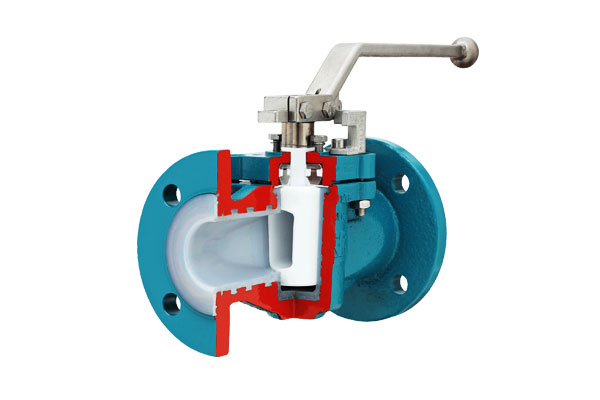
Key Vožtuvo komponentai
- Kūnas: Houses the plug and provides inlet/outlet connections (flanšas, sriegis, or welded).
- Įjungti: The rotating element, shaped either as a straight cylinder or a cone, containing the port(s).
- Seats: Provide sealing between plug and body; can be metal-to-metal surfaces or resilient inserts (Ptfe, guma).
- Kamienas & Handle/Actuator: Transmits torque from the operator (lever, gearbox, pneumatic or electric actuator) to the plug.
Operating Principles
Rotary Flow Control
Plug valves operate by rotating the plug around its axis—requiring just a quarter turn for full open or full close.
This allows rapid actuation: typical manual operation takes less than one second, and automated pneumatic or electric actuators can complete the stroke in 0.5–2 seconds.
Seal Formation
- Metal‑to‑Metal Seals: The plug’s hardfaced surface (often coated with Stellite) directly contacts the body’s bore.
Under line pressure, the plug presses into the body, enhancing the seal.
These valves withstand temperatures up to 550 °C and high‑pressure applications (ANSI Class 600 and above), but require higher break‑away torque (100–500 Nm for DN 50–200 valves). - Resilient (Minkšta) Seats: Elastomeric or PTFE rings around the plug bore provide a conforming seal with minimal torque (10–50 Nm for DN 15–100 valves).
Soft‑seated plug valves achieve bubble‑tight shutoff per API 598 but are typically limited to temperatures below 200 °C and pressures under ANSI Class 300.
Torque Requirements & Įjungimas
Torque to operate a plug valve depends on size, seat type, and service conditions. As a rule of thumb:
- Soft‑seated DN 50 valves require ~15 Nm to open; soft‑seated DN 200 valves up to 60 Nm.
- Metal‑seated DN 50 valves may need 100 Nm; metal‑seated DN 200 valves up to 400 Nm.
Manual Actuation: Lever or handwheel, often with a gearbox for larger valves.
Pneumatic Actuation: Double‑acting or spring‑return cylinders for rapid, reliable quarter‑turn operation—cycle times <1 s.
Electric Actuation: Offers precise position control and feedback for integration with DCS/SCADA systems; typical stroke times of 2–5 s.
3. Types and Basic Designs of Plug Valve
Plug valve is engineered in various configurations to meet a wide range of process requirements.
Key design distinctions are based on lubrication method, plug geometry, port configuration, and internal flow path.
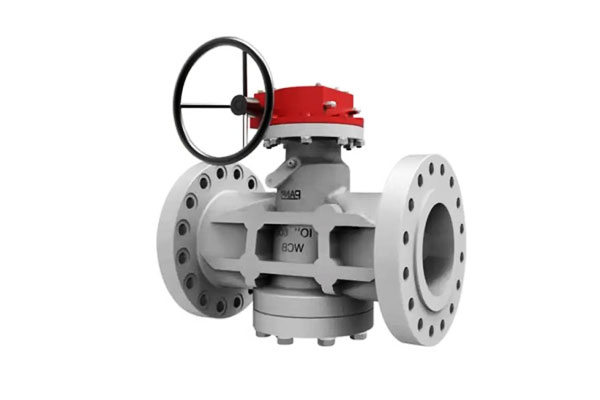
Lubricated vs. Non-Lubricated Plug Valves
- Lubricated Plug Valve
These valves rely on the injection of a sealant—typically a graphite- or PTFE-based compound—between the plug and the valve body.
The lubricant serves multiple roles: it reduces friction during operation, enhances sealing integrity, and provides a protective barrier against corrosive or abrasive media. - Non-Lubricated Plug Valve
These designs use self-lubricating materials—such as PTFE (Politetrafluoretilenas) with glass fiber reinforcement—for the seat or employ hard-coated plugs (Pvz., electroless nickel or hard chrome coatings with surface hardness > 60 HRC) to minimize friction.
Plug Configurations: Cylindrical, Conical & Trunnion-Mounted
- Conical (Tapered) Įjungti
Featuring a taper that matches the valve body’s seat angle, conical plugs are self-aligning under line pressure, providing a more secure and leak-tight seal.
They are especially effective in high-pressure applications (≥2,500 psi / 172 Baras). - Cylindrical Plug
These plugs have parallel sides and rely on spring-loaded seats or resilient inserts to maintain contact.
Cylindrical configurations are better suited for low to moderate pressure systems and are often used in compact or low-cost valve designs. - Trunnion-Mounted Plug
In this design, the plug is guided by upper and lower trunnions, which reduce torque requirements and wear on sealing surfaces.
This structure is preferred for large-diameter valves (≥12″) or extremely high-pressure applications (iki 15,000 psi / 1,034 Baras), such as subsea or high-integrity pressure protection systems (HIPPS).
Multi-Port Plug Valve
- Three-Way Plug Valve
Designed with L-shaped or T-shaped plug passages to divert flow between three ports.
Common in mixing, bypassing, or diverting services (Pvz., blending hot and cold water streams, sampling systems, or line switching). - Four-Way Plug Valve
Include cross-shaped or double-L internal passages to reroute flow between two inlet-outlet pairs.
These are widely used in batch chemical operations and reactor feed alternation, allowing complex process sequences with minimal valve count.
Port Size Configurations: Full-Port vs. Reduced-Port
- Full-Port Plug Valve
The internal flow passage matches the diameter of the connecting pipeline (Pvz., a 2-inch valve has a 2-inch port).
This design minimizes pressure drop and is essential where flow efficiency or pigging is critical.
Typical Cv for 2″ full-port plug valve: ~50. - Reduced-Port Plug Valve
The flow path is one nominal pipe size smaller than the inlet/outlet connections (Pvz., a 2-inch valve with a 1.5-inch bore).
This design reduces material and manufacturing costs but introduces a higher pressure drop.
Typical Cv for 2″ reduced-port valve: ~ 30.
4. Materials and Construction of Plug Valve
The material selection and construction of a plug valve are critical to its performance, patvarumas, and chemical compatibility in demanding industrial environments.
Each component—the body, įjungti, Sėdynės, and internal seals—is engineered using materials tailored to withstand specific pressures, temperatūra, and process media.

Kūnas & Plug Materials
| Medžiaga | Standard/Grade | Pagrindinės savybės | Tipiškos programos |
| Ketaus | ASTM A126 Class B | Ekonominis, suitable for low-pressure systems; limited corrosion resistance | Water supply, ŠVOK, municipal systems |
| Anglies plienas | ASTM A216 WCB | High mechanical strength; suitable for medium-high pressure/temperature | Aliejus & dujos, garas, petrochemical pipelines |
| Nerūdijantis plienas | ASTM A351 CF8/CF8M (316SS) | Puikus atsparumas korozijai, especially against chlorides and acids | Chemical plants, food/pharma, Jūrų aplinka |
| Nikelio lydiniai | Hastelloy C-276, Inconel 625, Monel 400 | Superior resistance to aggressive chemicals and high temperatures | Acid handling, jūroje, gas scrubbing |
| Kariuomenė geležis / Bronza | ASTM A536 / ASTM B62 | Good mechanical properties with cost-effectiveness | Žemės ūkis, geriamasis vanduo, general plumbing |
Sėdynė & Liner Materials
| Medžiaga | Tempų diapazonas | Pagrindinės savybės | Recommended Services |
| Ptfe (Teflonas) | –50°C to +230°C | Maža trintis, excellent chemical inertness | Maistas, Pharma, corrosive chemical handling |
| Filled PTFE | –50°C to +260°C | Reinforced with glass or carbon for better wear and strength | High-cycle chemical systems |
| Elastomerai (EPDM, FKM) | –30°C to +200°C | Good sealing flexibility, resistant to water, oras, and light hydrocarbons | Vandens valymas, ŠVOK |
| Lankstus grafitas | –200°C to +540°C | High-temp resistance, fire-safe; used in critical sealing | Steam lines, refinery, high-temp pipelines |
| Metalas iki metalo (Stellite, Chrome-Plated) | Up to 650°C | Hard sealing surface for erosive or abrasive fluids | Slurries, abrasive oils, fertilizer plants |
Lubricants (for Lubricated Plug Valves)
| Lubricant Type | Pagrindinės charakteristikos | Service Suitability |
| Graphite-Based Grease | High-temperature resistance, maža trintis | Garas, heavy oil, refinery applications |
| Ptfe / MoS₂ Compounds | Low coefficient of friction, chemically inert | Corrosive gas, chemical feedlines |
| Silicone-Based Sealants | Neutral behavior, effective in a wide temperature range | Natural gas distribution, general service |
5. Performance Characteristics of Plug Valve
Plug valves are known for their simple operation, robust sealing, and bidirectional flow capabilities.
Tačiau, their performance varies significantly based on design, Medžiagos pasirinkimas, and service conditions.
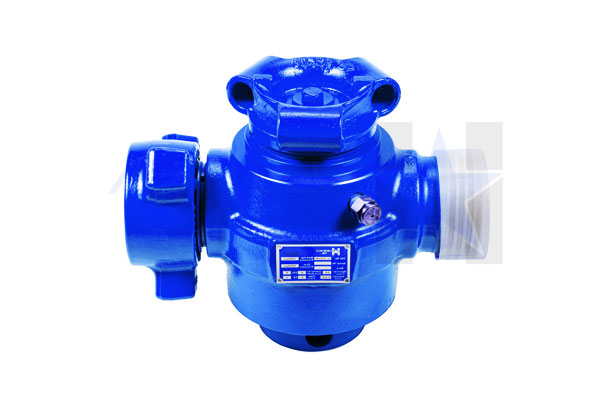
Pressure-Temperature Ratings
Plug valves are rated according to industry standards such as API 599 ir ISO 17292, which define safe operating pressure limits at various temperatures.
These ratings depend heavily on the valve’s kūno medžiaga ir seat design.
| Medžiaga | ASME Class | Max Pressure (psig) | Max Temp (° C.) |
| Anglies plienas (WCB) | 150 | ~285 @ 38°C | ~425°C |
| Nerūdijantis plienas (CF8M) | 300 | ~740 @ 38°C | ~540°C |
| Lydinys (Inconel 625) | 600 | >1,480 @ 38°C | >650° C. |
Seal Tightness & Leakage Classes
Plug valves, especially with soft seats or injected grease, can achieve bubble-tight shutoff. Leakage standards are tested per:
- API 598: Pressure test protocol for industrial valves
- ISO 5208: Valve leakage classification
- Leakage Class VI (soft seat): Essentially zero visible leakage
- Leakage Class IV (metal seat): Acceptable for most industrial gas and liquid services
Lubricated plug valves rely on grease to maintain seal integrity and require periodic re-injection, kol non-lubricated versions use elastomer or PTFE sleeves that can wear over time.
Flow Characteristics (Cv Values)
Plug valves exhibit linear or equal-percent flow control behavior, depending on port geometry (round vs. rectangular or V-notch).
Though primarily used for isolation, some plug designs allow moderate throttling.
- Full-Port Plug Valve (2-coliai):
-
- Cv ≈ 45–55 (high flow efficiency)
- Reduced-Port Plug Valve (2-coliai):
-
- Cv ≈ 25–35 (higher pressure drop)
CV (Flow Coefficient) represents the flow rate in gallons/minute of water at 60°F that will flow through the valve with a 1 psi pressure drop.
Torque Requirements & Įjungimas
Plug valves typically require higher operating torque than ball or butterfly valves due to larger contact areas between the plug and seat.
| Vožtuvo tipas | Typical Torque (Nm for 2″ Valve) |
| Lubricated Plug Valve | ~50–100 Nm (depends on lubricant film) |
| PTFE-Lined Plug Valve | ~30–60 Nm |
| Metal-Seated Plug | >100 Nm (requires gear or actuator) |
6. Application Fields of Plug Valves
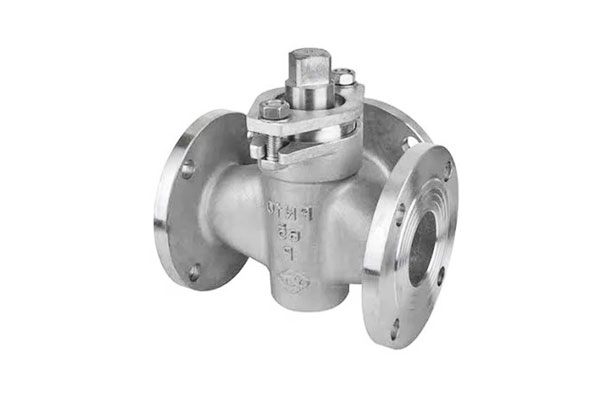
- Aliejus & Dujos (Upstream, Midstream, Downstream)
- Cheminė & Petrochemical Industry
- Vanduo & Nuotekų valymas
- Energijos generavimas
- Pulp & Paper Industry
- Kasyba & Mineral Processing
- ŠVOK & Building Services
- Maistas & Beverage Industry
- Jūrų & Offshore Engineering
- Farmacija & Biotech Industry
- LNG & Cryogenic Systems
- Plienas & Metallurgical Plants
- Rafinavimas & Bulk Storage Terminals
- Textile & Dyeing Industry
- Fire Protection Systems
7. Advantages and Limitations of Plug Valve
Advantages of Plug Valve
- Simple Design: Minimal internal components, making maintenance straightforward.
- Quick Operation: 90-degree quarter-turn allows fast open/close action.
- Tight Shutoff: Excellent sealing capability, especially with resilient seats or lubricant.
- Bidirectional Sealing: Seals effectively in both flow directions.
- Compact Size: Short face-to-face dimensions compared to gate or globe valves.
- Multi-Port Options: Available in 3-way or 4-way configurations for flow diversion or mixing.
- High Durability: Suitable for abrasive, korozija, or slurry media (with appropriate materials).
- In-Line Maintenance: Many designs allow servicing without removing the valve from the pipeline.
Limitations of Plug Valve
- High Operating Torque: Especially in metal-seated or larger valves; may require gear or actuator.
- Friction Wear: Metal-to-metal designs can experience galling and wear over time.
- Lubrication Needs: Lubricated plug valve require periodic re-greasing to maintain sealing and ease of operation.
- Kaina: Can be more expensive than ball valves in similar pressure/temperature ranges.
- Limited Throttling: Not ideal for precise flow control due to potential erosion and wear in partially open positions.
- Size Constraints: Less common in sizes above 24 inches due to torque and manufacturing limits.
8. Palyginimas: Plug Valve vs. Ball, Gate, and Butterfly Valves
| Aspektas | Plug Valve | Rutulinis vožtuvas | Vartų vožtuvas | Drugelio vožtuvas |
| Dizainas | Simple body and tapered/cylindrical plug | Rotating spherical ball with bore | Rising wedge or parallel gate disc | Disc rotates on a central shaft |
| Operation | 90° quarter-turn | 90° quarter-turn | Multi-turn (slow) | 90° quarter-turn |
| Sealing Capability | Puiku (especially lubricated types) | Labai gerai (griežtas uždarymas) | Gerai (metal-to-metal contact) | Moderate to good (depends on seat design) |
| Droselis | Ribotas, not recommended | Ribotas (not ideal for throttling) | Acceptable for minimal control | Fair to good control depending on design |
| Torque Requirements | Aukštas, especially for larger valves | Vidutinis | Low to high (depending on pressure/size) | Žemas ar vidutinio sunkumo |
| Priežiūra | Vidutinis (lubrication required for some types) | Žemas (minimal maintenance) | Aukštas (seat wear, stem packing) | Žemas ar vidutinio sunkumo |
| Suitability for Slurry/Abrasive Media | Gerai (especially with metal seats) | Vargšas (may clog or erode ball seat) | Mugė | Fair to good with suitable disc materials |
| Multi-Port Options | Taip (3-way, 4-way) | Taip (limited 3-way availability) | Ne | Ne |
| Slėgio kritimas | Žemas ar vidutinio sunkumo (depends on port size) | Žemas (full bore design) | Žemas | Vidutinis |
| Space Requirement | Compact face-to-face, larger actuator for torque | Kompaktiškas | Long face-to-face (vertical space needed) | Very compact |
| Kaina | Vidutinio sunkumo iki aukšto (especially metal-seated) | Vidutinis | Žemas ar vidutinio sunkumo | Žemas ar vidutinio sunkumo |
| Paraiškos | Cheminė, aliejus & dujos, srutas, multi-directional flows | General use, vanduo, aliejus & dujos, shutoff | Waterworks, isolation, non-frequent operation | ŠVOK, vanduo, low-pressure gas, large pipe diameters |
Santrauka:
- Use Plug Valves when you need tight shutoff, bidirectional sealing, or multi-port flow in tough services like slurries or chemicals.
- Rutuliniai vožtuvai are ideal for fast shutoff and minimal pressure drop in clean media applications.
- Gate Valves suit infrequent isolation in large-bore systems.
- Drugelio vožtuvai excel in space-limited, low-pressure environments with large diameters.
9. Sizing, Selection & Installation Guidelines
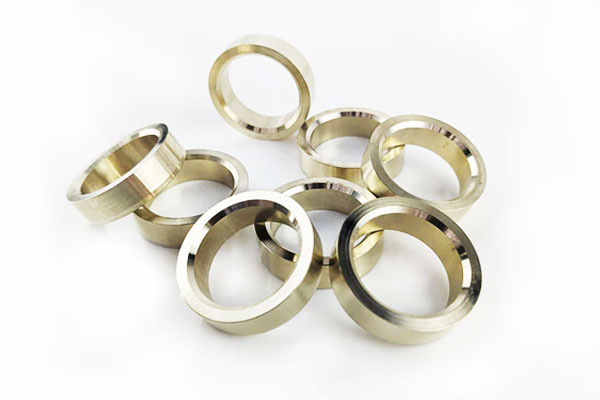
- Media and Conditions: Match body and seat materials to fluid chemistry, temperatūra, ir spaudimas.
- Sizing: Use Cv calculations to ensure required flow at expected ΔP; select actuators to deliver 1.5× break‑away torque.
- Installation: Orient plug vertically in lubricated valves to prevent grease pooling; maintain 1× valve length of straight pipe on each side for optimal performance.
10. Priežiūra, Tikrinimas & Trikčių šalinimas
- Tepimas: Every 6–12 months or 5,000 ciklai; use manufacturer‑approved grease.
- Seat Replacement: In many designs, seats can be changed in-line without body removal.
- Common Issues: Galling on metal seats remedied by relubrication; graphite packing leaks corrected by repacking; plug erosion addressed by Stellite overlays or seat refurbishment.
11. Standartai, Certifications & Testing
- API 599: Inspection and test procedures.
- ISO 17292: Performance requirements for plug, rutulys, and butterfly valves.
- MSS SP‑79/SP‑80: Guidelines for lubricated and non‑lubricated plug valves.
- Certifications: API Monogram, CE marking, SIL ratings for safety instrumented systems.
12. Išvada
Plug valves offer a unique blend of simplicity, speed, ir universalumas across a diverse array of process industries.
By carefully selecting body, įjungti, and seat materials—and by adhering to best practices in sizing, installation, and maintenance—engineers can leverage plug valves for reliable isolation, diversion, and rudimentary flow control in virtually any fluid service.
Tai: Didelio tikslumo vožtuvų liejimo sprendimai reikalaujantiems pritaikymo priemonėms
Tai yra specializuotas tikslaus vožtuvų liejimo paslaugų teikėjas, Pristatyti aukštos kokybės komponentus pramonės šakoms, kurioms reikalingas patikimumas, slėgio vientisumas, ir matmenų tikslumas.
Nuo neapdorotų liejinių iki visiškai apdirbtų vožtuvo korpusų ir mazgų, Tai Siūlo „Solutions Solutions“, sukurtus, kad atitiktų griežtus pasaulinius standartus.

Mūsų vožtuvo liejimo patirtis apima:
Investicijų liejimas vožtuvų kūnams & Apdaila
Utilizing lost wax casting technology to produce complex internal geometries and tight-tolerance valve components with exceptional surface finishes.
Smėlio liejimas & Korpuso pelėsio liejimas
Idealiai tinka vidutinio ir didelio vožtuvo kūnams, flanšai, ir variklio varikliai-renkantis ekonomišką sprendimą tvirtoms pramoninėms reikmėms, įskaitant aliejų & dujų ir energijos gamyba.
Tikslus vožtuvo apdirbimas & Antspaudo vientisumas
CNC apdirbimas vietų, Siūlai, O sandarinimo veidai užtikrina, kad kiekviena išmetimo dalis atitiktų matmenų ir sandarinimo našumo reikalavimus.
Medžiagų diapazonas kritinėms reikmėms
Nuo nerūdijančio plieno (CF8/CF8M/CF3/CF3M), Žalvaris, Kariuomenė geležis, į dupleksines ir aukšto lydinio medžiagas, Tai atsargų vožtuvų liejiniai, sukurti atliekant koroziją, aukšto slėgio, arba aukštos temperatūros aplinka.
Whether you require custom-engineered control valves, plug valves, Žemės rutulio vožtuvai, vartų vožtuvai, arba didelės apimties pramoninių vožtuvų liejinių gamyba, DEZE is your trusted partner Tikslumui, patvarumas, ir kokybės užtikrinimas.
DUK
When should I choose a plug valve over a ball valve?
Opt for plug valves in high‑temperature or abrasive services, or where simple quarter-turn, bidirectional operation is needed.
How often should a lubricated plug valve be re-lubricated?
Typically every 6–12 months or after 5,000–10,000 cycles, depending on service severity.
Can plug valves be used for throttling service?
Limited throttling is possible with equal‑percent plugs, but seat wear increases; globe valves excel at precise flow control.
What causes plug valve leakage and how is it fixed?
Wear or damage to seats and plugs leads to leakage; remedy via seat replacement, plug re-lapping, or re-lubrication for metal‑to‑metal valves.



